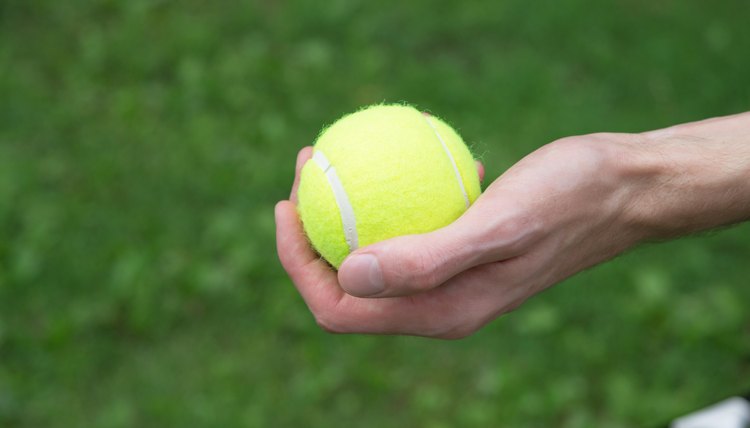Tennis Ball Exercises for Carpal Tunnel

Carpal tunnel syndrome is a painful disorder that can develop in your hands or wrists from repetitive use or an injury that causes the median nerve in your wrist to become inflamed. One way minor cases can be treated is by using a common item you most likely have around your house -- a tennis ball. Yes, that yellow, fuzzy item that you play tennis with or teach your dog to fetch can be used to treat your carpal tunnel through four different exercises.
Squeezing Exercise
The first way to alleviate carpal tunnel with a tennis ball is to follow a simple squeezing routine. Hold the ball in the center of your hand, squeeze it for five seconds and release your grip. "Ultimately, what this does is strengthen your wrists. As your wrist muscles get stronger, they protect the sheaths that the tendons go through that cause carpal tunnel syndrome," says the website Muscle Building Techniques. Do as many repetitions as needed. The best time to do this is while watching TV, as it can pass the time during those annoying commercial breaks.
Rolling Exercise
Place a tennis ball on a table and the palm of your hand on top of the ball. Roll your hand around the ball, making circular and up and down motions, then do the same with the other hand. This relaxes and relieves tension in your wrists, hands and fingers, according to MicroMoves.
Massage Exercise
Use a tennis ball to massage your aching wrists and alleviate carpal tunnel pain. "Using a tennis ball and your other hand, gently massage the tendons through the forearm and wrist in a circular motion along the length of the arm," explains musician David Sawyer.
Finger Stretch Exercise
Sawyer also recommends a finger stretch exercise for carpal tunnel syndrome. While standing up, put your hand flat on a table and put a tennis ball under one finger at a time. Do this for eight seconds for each finger. This exercise stretches out tendons that run from your fingers through your wrists.
References
- Presazzi A, Bortolotto C, Zacchino M, Madonia L, Draghi F. Carpal tunnel: Normal anatomy, anatomical variants and ultrasound technique. J Ultrasound. 2011;14(1):40-6. doi:10.1016/j.jus.2011.01.006
- Goitz RJ, Fowler JR, Li ZM. The transverse carpal ligament: anatomy and clinical implications. J Wrist Surg. 2014;3(4):233-4. doi:10.1055/s-0034-1394150
- Cleveland Clinic. Carpal tunnel syndrome. Updated October 22, 2019.
- Aboonq MS. Pathophysiology of carpal tunnel syndrome. Neurosciences (Riyadh). 2015;20(1):4–9.
- Cleveland Clinic. Carpal tunnel syndrome: Diagnosis and tests. Updated October 22, 2019.
- Page MJ, O'connor D, Pitt V, Massy-Westropp N. Exercise and mobilisation interventions for carpal tunnel syndrome. Cochrane Database Syst Rev. 2012;(6):CD009899. doi:10.1002/14651858.CD009899
- Newington L, Harris EC, Walker-Bone K. Carpal tunnel syndrome and work. Best Pract Res Clin Rheumatol. 2015;29(3):440–453. doi:10.1016/j.berh.2015.04.026
- Wright AR, Atkinson RE. Carpal tunnel syndrome: An update for the primary care physician. Hawaii J Health Soc Welf. 2019;78(11 Suppl 2):6–10.
- Cleveland Clinic. Carpal tunnel syndrome: Management and treatment. Updated October 22, 2019.
Writer Bio
David Longnecker started his writing career in college as an intern for ChristianBeats. He has been published in "Breakaway Magazine," covered fantasy sports for several online publications and currently serves as an Web writer/producer. Longnecker holds a bachelor's degree in religious education and a master's degree in professional writing from Chatham University.
